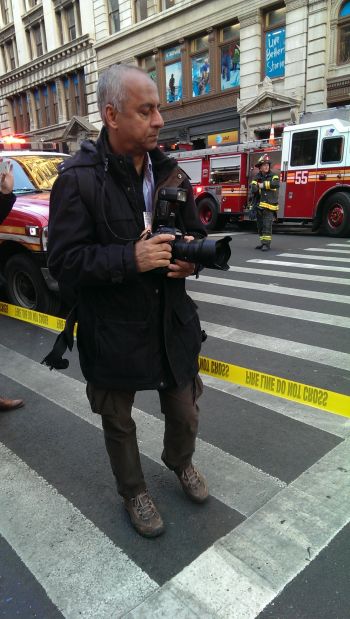
Umar Abbasi Nov. 4 2013 on Broadway in Soho fire scene. (Credit: Rhonda Roland Shearer)
Story Highlights
- Abbasi was closer to the incident than he claimed
- Abbasi was not running when he was taking pictures
- Abbasi only moved a few dozen feet between shooting his three published photographs
New York Post freelance photographer R. Umar Abbasi’s story has changed and further investigation into his photographs throws even more doubt on his claims of heroically trying to save Ki-Suck Han, who this week was thrown in front of a subway train and fatally struck. Abbasi’s own words contradict his photographs when the images are reconstructed using subway platform measurements.
iMediaEthics went to the 49th Street and 7th Avenue N, R and Q subway station and examined the platform where Han was tragically killed Monday, December 3. We used Abbasi’s published images as a guide to create approximations. These reconstructions indicate where Abassi was standing when he was taking the three photographs that the Post published. There is some limitation not knowing exactly what lens and settings Abbasi was using at the time. However, the downward angle the photographs were shot from and how little this angle changes in the different shots support that Abbasi was not only much closer to Han when he was pushed but also that his claims of running are likely false. We have provided a method statement at the end of the article.
Background: On December 3, 2012, Ki-Suck Han was pushed to his death allegedly by a Naeem Davis, 30, who has since been arrested for the crime. The two were videotaped arguing by a bystander before Davis allegedly hurled Han to his death. Han’s final moments were captured by freelance photographer R. Umar Abbasi. One of the several photographs that Abbasi took of the transpiring tragedy was made infamous when the New York Post published it on its front page with the headline “DOOMED.” Since that time, the Post and Abbasi have been the subject of much criticism.
Abbasi has offered his version of events in the Post’s December 4 article about Han’s death, in his own December 5 Post editorial defending his actions, and in a December 5 interview on the Today show. A close comparison of what Abbasi says in each piece reveals important variations and holes in his various versions of the story.
Abbasi’s Story in pictures, Challenged by measurements
R. Umar Abbasi has told the same basic story from the beginning: He was far away from and unaware of the argument that took place between the Davis and Han. He claims he saw, out of the corner of his eye, Han fly through the air. He realized that he could not help the man physically so he decided to use his camera’s flash to warn the train driver to stop. So he ran toward the train flashing his camera. The train slowed but could not stop in time. It was only later that Abbasi realized he had captured any pictures at all. It was pure luck. The New York Post approached him to use the photographs and he agreed.
Now, let’s take a closer look at Abbasi’s story.
Abbasi claims he was far away from the scene of the argument. When asked on the Today show how far he was from Han when everything started, Abbasi answered, “The platform is about 500 or 600 feet long, I checked, I was 100 or maybe 150 feet into the platform.”
That is an interesting non-answer. If he was 100-150 feet from the end of the platform, he would be approximately 250-300 feet from the place where Han fell. He also says that the arrival of the train was announced just before Han was pushed. At what point did he start running? Did he start flashing his camera right away? Or did he wait until he saw the train?
If we take a look at the first photo in time of those published, it provides some answers.

Abbasi’s Photograph #1 You can see Davis, the alleged pusher, on the left and Han can barely be discerned sitting on the tracks. In the distance there are no train’s lights yet visible. (Credit: photo of Post print version R. Umar Abbasi)
Here you see Davis, the deranged man, a shadowy figure on the left, who allegedly threw Han on the tracks. Several witnesses confirmed that the assailant left the scene immediately after the assault and the Post article confirms:
“As the train’s arrival was announced over the loudspeaker, the attacker ‘just grabbed [Han] and launched him — just threw him — straight onto the tracks,’ a witness said. The killer then grabbed a paper coffee cup he used to collect change — which he’d put down before the assault — and fled.”
In the first Post article about Han’s death, Abbasi says:
“As I was running toward the train, the man I believe pushed him ran the other way, and I heard him say, ‘Goddamn motherf–ker.’ I didn’t think about [the perp] until after. In that moment, I just wanted to warn the train — to try and save a life.”
However, when Abbasi was interviewed on NBC’s December 5, Today show by Matt Lauer and Savannah Guthrie, his story had changed. Suddenly not only was he aware of the man who pushed Han despite being (his claim) hundreds of feet away, he is also now in fear of his life. Abbasi said:
“In this process while I’m running the person who pushed him is coming towards me and there’s a lapse in there where I press myself with my back to the wall because I don’t want to be pushed onto the tracks.”
NBC’s Lauer asked Abbasi directly if his only intention was to warn the train and not take pictures. He said “yes.” Was Abbasi flashing his camera to warn a train that he can’t even see?

Approximation of Abassi’s Photograph #1 taken about 38 feet from where Han was fatally struck by the subway train. The train’s lights are also not visible. (Credit: London Shearer Allen)
Above is a picture that approximates Abbasi’s Photograph #1; iMediaEthics went to the station the evening of December 5, 2012, in order achieve an aproximate picture the camera had to be around 38 feet from where Han was struck. We determined the location of Han with visual clues in Abbasi’s three photographs such as the pipe on the wall, the line on the floor and the posters.
Abbasi’s Photograph #1 was apparently taken very shortly after Han was pushed since Davis is still there and there is no train light visible in the distance. The approximation demonstrates that with the angle the platform is viewed in Photograph #1 it could not have been taken 150 feet further away as Abbasi claims.
An undisclosed person filmed Han and Davis arguing before he was pushed onto the tracks. The video is shot from the opposite direction that Abbasi was shooting from.
It is safe to assume that one of the men in the background is Abbasi, since his photographs are shot from that direction and were taken moments after this video was shot.. Just to the left of Han, you can see a man in a green jacket who stands near a trash can that is 60 feet away from where the argument took place. Abbasi was photographed the next day in a similar green jacket. Although not conclusive it is interesting that a man in a green jacket similar to Abbasi’s is standing within 20 feet of where we have estimated Photograph #1 was shot. (iMediaEthics did another investigation except it was about a brown jacket man)

Map of 49th Street Q train South bound platform. (Credit: Alberto Mena)
In Abassi’s next image, Photograph #2, Han is clearly visible on the tracks, sitting, and perhaps struggling to get up. The approaching train lights are now just visible in the distance. Take note of the red marks next to Han.

Abbasi’s Photograph #2: Han is on the tracks after being pushed. Take note of the train lights in the distance and the two red marks to the left of Han. (Credit: Photo from NY Post, print version)
The approximation iMediaEthics made of Photograph #2 was taken by moving forward 14 feet from the place Photograph #1 was taken (approximately 24 feet from the place Han sat). The red dots in the recreated image are a similar distance apart as they are in Abbasi’s Photograph #2. The red dots are actually two bolts spray painted orange on the subway track. Because these bolts are fixed in space they can be used to accurately judge the distance and position of the photographer is from them. The farther away from the bolts, the closer they appear to be to each other until they merge into one red mark.
We can conclude then that Photograph #2 was taken at a similar distance from Han as our approximation. This places Abbasi around 24 feet from Han at the time the picture was taken. It also means that Abbasi moved 14 feet between photographs #1 and #2.
It is difficult to say how much time has elapsed between Photograph #1 and Photograph #2 since no information about the times have been released by the Post or by Abbasi and there are few clues in the picture. Therefore we can’t determine based on elapsed time if Abbasi was running at this point but clearly controlled framing and composition (which we discussed in depth in an earlier article) suggests he was not.
.jpg)
(top) The approximation of Abbasi’s Photograph #2 shows the position of the painted bolts in relation to each other. The blue marker shows Han’s position in Photograph #3 The blue oval represents Han sitting on the tracks. Note in the distance two more painted bolts that appear much closer together.

The two painted bolts are seen in the recreation that are also seen in Abbasi’s photo. (Credit: London Shearer Allen)
In Photograph #3, the one made famous on the cover of the New York Post on December 4, Han is now standing and apparently trying to climb back up to the platform. The train has advanced approximately 300 – 500 feet. If we assume the train was traveling on average 15 miles per hour (accounting for the rapid braking of the driver), then it was moving 22 feet per second. Somewhere between 14 and 22 seconds has elapsed between Photograph #2 and Photograph #3.

Abbasi’s Photograph #3: Han is shown against the platform edge almost directly across from where he was arguing with Davis. (Credit: Screen shot NY Post)
In our approximate version of the un-cropped front page photo (Photograph #3), the blue pin represents where Han was at the edge of the platform when he was struck by the train. iMediaEthics recreated the image by walking 9 feet from the location where Photograph #2 was shot and angled away from the platform edge (it took us around two seconds to cover the distance). The change in angle and distance from the platform edge indicates that Abassi moved away from the tracks as the train neared. As the train moved closer stepping away and toward the wall would give him a better angle to feature the train in the photograph.
During the 14 to 22 seconds that elapsed between photos #2 and #3 Abbasi moved approximately eight feet closer to the train and two to three feet away from the edge of the platform. That has him moving at less than a foot a second, hardly the frantic run to alert the driver that Abbasi claims.

Reconstruction of photograph #3. The blue pin represents approximately where Han was fatally struck. Take notice the pipe on the wall and the subway sign in the distance. (Credit: London Shearer Allen)
In the Today interview and his Post editorial, Abbasi said he thinks 22 seconds passed between the moment Han fell on the tracks and when he was killed. Such a precise estimation gives the impression that Abbasi has checked the times stamps on his pictures but this is speculation because as no data has been forthcoming from either Abbasi or the Post despite requests.
Abbasi’s outrage?
Abbasi has expressed disgust and disbelief at the actions and inactions of other people on the scene. In his Post editorial, he said:
“The sad part is, there were people who were close to the victim, who watched and didn’t do anything. You can see it in the pictures.”
And on Today he elaborated further:
“The people who were standing closer to him on the 50th Street exit. They could have moved and grabbed him and pulled him out. Nobody made an effort.”
When you examine the other people in Abbasi’s pictures (#1 and #3), it is difficult to tell exactly how far away they are; however, you can see that they are behind or in front of certain objects, which can be used as reference points. In Abbasi’s photo below (top), you can make out a crowd of people in the distance on the left. They are beyond the circled subway sign, which is 76 feet away from where Han was killed. In the video still below (bottom), you can see people on the left, standing in front of a dark area overhang that is 66 feet away from Han. (The dark area is a place where the lighting changes and creates a shadow.) So it appears that the people near the 47th street exit, where Abbasi was, were actually closer to Han than the people at the 50th street exit as Abbasi claims.
.JPG)
Abbasi’s Photograph #1 The people in the background are past the subway sign, making them more than 76 feet away. (Credit: New York Post)
Video still that shows Han and Davis arguing. The dark area is a shadow created by a change in lighting fixtures. It is around 66 feet from Han and Davis, making the people standing in front it closer than that. (Credit: Screen shot CBS News)
To this date Abbasi has avoided answering if he took any photographs of Han’s remains. It also must be noted that besides the video of Davis and Han arguing and the photographs that Abbasi sold to the Post, no other images of Han’s death have surfaced. It would seem that if Abbasi was right about a heartless group of strangers whom he had to push back because they were shooting video of Han’s dead body, then at least those strangers had the decency to keep it to themselves.
Editors Note: In addition to having written NY Post previously, we have written to Mr. Abbasi before and after publication asking for comment and to see other images from the series and the meta data from the photos. We are hoping for a response and will update.
Method Statement: The approximations of the photograph were created by noting key features in the images. For example a red pipe, a line in the platform or a green sign. We then moved around trying to recreate not only the positions of the key elements but also replicate the angle from which they were shot. We found that the distance from the elements affects the angles. The farther away from the object the higher you must be in order to replicate the angle of a photograph taken from a closer vantage point.
Although we are aware that which lens used, settings of the aperture and shutter speed and cropping can affect an image greatly it has little effect on the angle and perspective of objects in a picture. These are most affected by distance, height and sight lines. Our main focus was getting an approximately similar composition with similar perspective and angles.
The distances between the places the three photographs were taken were measured with a tape measure. The rest of the measurements taken by carefully pacing off the distances, making these measurements more approximate. This was done because a NYPD officer informed IMediaEthics on the scene that it is illegal to measure any part of the transit system without a permit.






